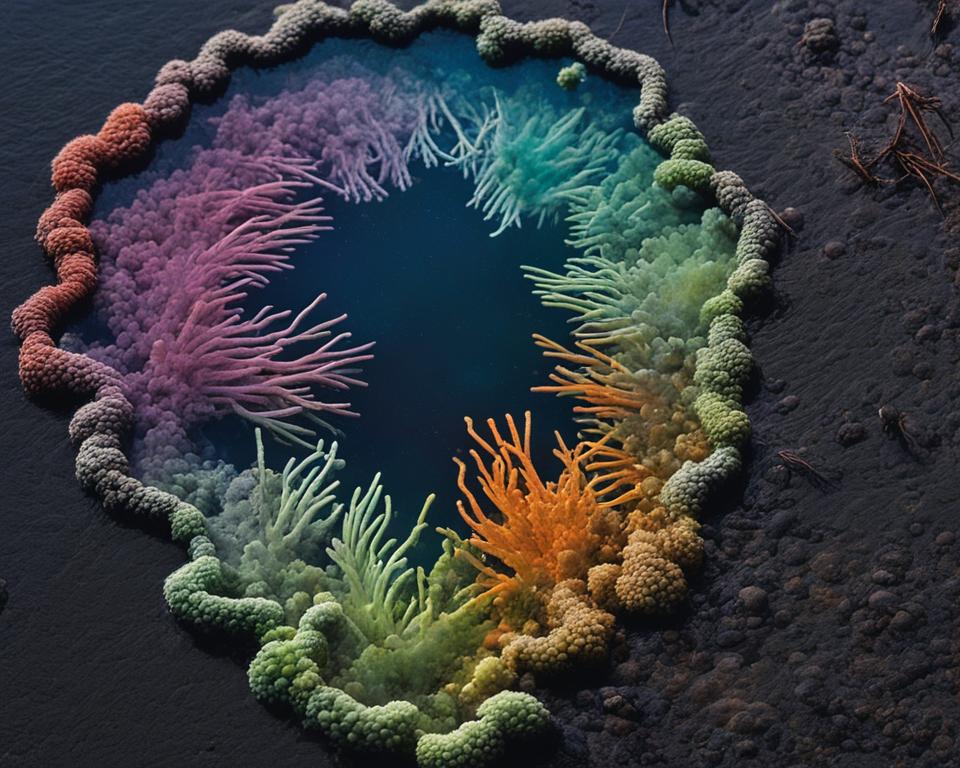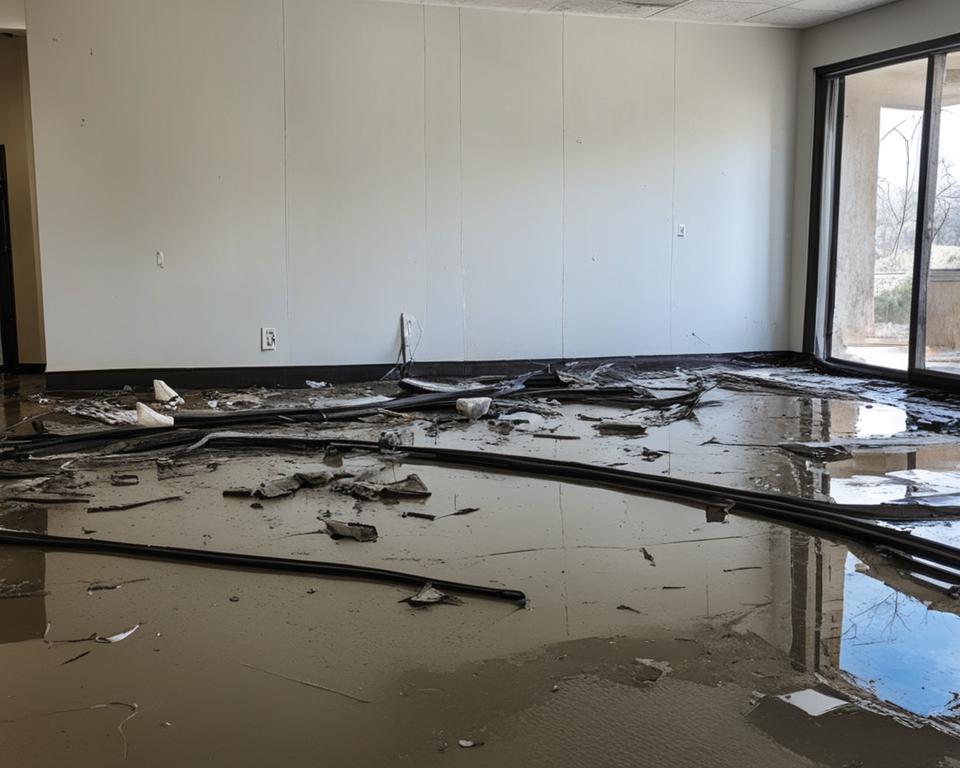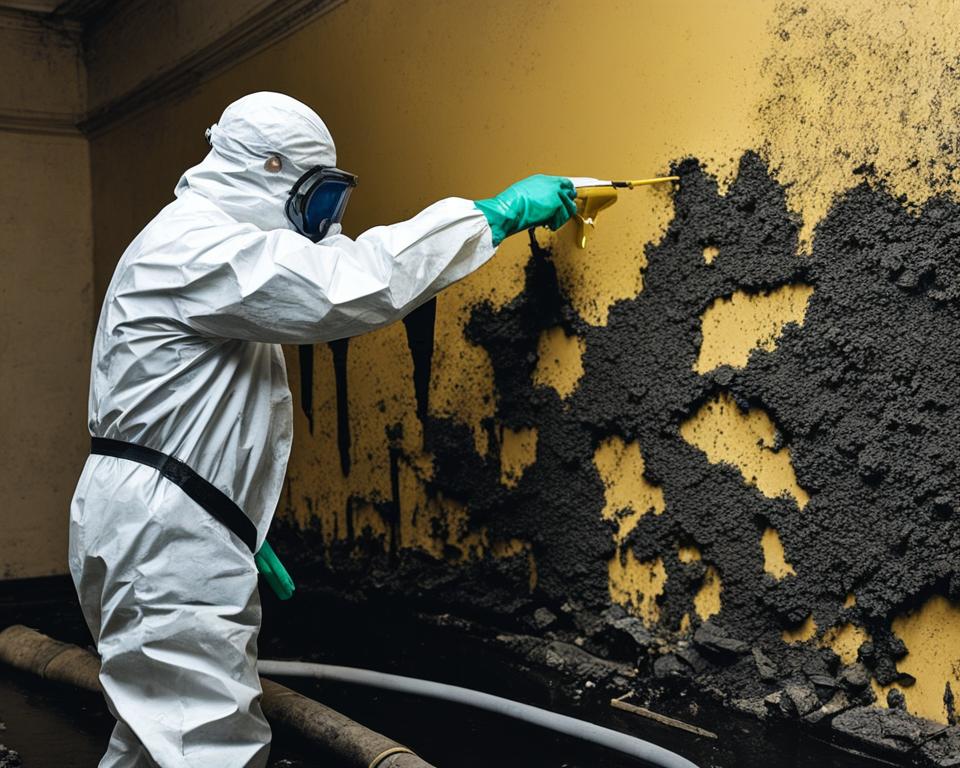Water damage restoration can pose several health hazards if not addressed properly. Mold growth is a common concern, as it can thrive in moist environments and lead to poor air quality. Bacterial growth is another hazard, especially with category 3 water damage, as it can introduce harmful pathogens. Structural damage is also a risk, as it can compromise the integrity of the building. To avoid these hazards, it’s important to act quickly, wear protective gear, and seek professional help when needed.
Key Takeaways:
- Rapid mold growth can occur in moist environments within 24-48 hours.
- Category 3 or black water contains sewage and can introduce dangerous bacteria.
- Water damage can lead to structural damage, compromising the building’s integrity.
- Mold exposure can trigger respiratory issues and allergic reactions.
- Waterborne pathogens in water damage can cause infections and worsen pre-existing conditions.
Mold Growth
One of the most significant health hazards associated with water damage is mold growth. Mold can proliferate rapidly in as little as 24-48 hours in a moist environment, posing serious risks to both the structural integrity of the building and the health of its occupants.
A variety of indoor molds are commonly found in water-damaged buildings, including Cladosporium, Penicillium, and Aspergillus. These molds can enter the home through various avenues, such as air circulation or water infiltration, and thrive in wet building materials.
Mold-friendly environments include materials such as paper products, wood, carpet, and fabric. These porous materials provide the ideal conditions for mold growth, offering organic matter that sustains their development and proliferation.
To prevent mold growth, prompt action is crucial. As soon as water damage is detected, it’s important to address the issue quickly and eliminate excess moisture. This can involve drying out the affected area, repairing leaks, and improving ventilation to reduce humidity levels.
Taking immediate action to address water damage and control moisture not only helps prevent mold growth but also ensures a healthier indoor environment for everyone. By prioritizing timely repairs and the implementation of proper moisture management strategies, individuals can minimize the risk of mold-related health issues and maintain the integrity of their homes or buildings.
Bacterial Growth
Water damage can introduce different categories of water, with category 3 or black water being the most hazardous. This type of water contains sewage and can harbor dangerous bacteria that can cause gastroenteritis, Weil’s Disease, Hepatitis, and other deadly diseases. It is important to leave flood cleanup to professionals to avoid exposure to these contaminants. If entering a flooded area is unavoidable, protective clothing and waterproof boots should be worn.

Structural Damage
Water damage has the potential to cause significant structural damage to a property, compromising its integrity and safety. When large quantities of water infiltrate a building, they can degrade building materials over time, leading to weakened structures and potential collapse. This degradation can impact not only the strength of the building but also its overall value.
One common consequence of water damage is the rotting of wood, a material commonly found in many structures. When exposed to moisture, wood can begin to decay, resulting in weakened beams, columns, or even framing elements. This rotting wood not only poses a hazard to occupants but also contributes to a poor air quality environment, potentially exacerbating respiratory issues.
Additionally, prolonged exposure to moisture creates an ideal environment for mold growth. Mold can thrive on various surfaces within a property, including walls, ceilings, and flooring. As mold spreads, it further deteriorates building materials, compromising their structural integrity. The presence of mold can also lead to poor air quality, increasing the risk of respiratory issues and allergic reactions.
To illustrate the impact of structural damage caused by water, consider the following table:
| Effects of Water Damage on Structure | Consequences |
|---|---|
| Degraded Strength | Weakened building materials, increased risk of collapse |
| Rotting Wood | Compromised structural elements, decreased property value |
| Poor Air Quality | Increased presence of mold spores, potential respiratory issues |
It is crucial to address water damage promptly and effectively to mitigate these structural risks. Seeking professional assistance in water damage restoration can help prevent further degradation and ensure the safety of the property and its occupants.

Respiratory Issues and Allergic Reactions
Mold exposure in water-damaged environments can have significant health effects, particularly on respiratory systems. Individuals exposed to mold may experience various respiratory issues such as wheezing, coughing, and shortness of breath. Those with pre-existing respiratory conditions like allergies or asthma are especially vulnerable to the detrimental effects of mold.
Mold and other contaminants present in water-damaged areas can also trigger allergic reactions. These reactions often manifest as sneezing, runny nose, itchy eyes, and skin rashes. It is essential to address water damage promptly to minimize respiratory issues and allergic reactions caused by mold exposure.
| Common Respiratory Issues | Symptoms of Allergic Reactions |
|---|---|
|
|
Infections and Aggravation of Pre-existing Conditions
Water damage can have severe consequences on individuals’ health, particularly in terms of infections and the aggravation of pre-existing conditions. When waterborne pathogens and contaminants are present in water damage situations, they can give rise to various types of infections, ranging from mild to more severe illnesses.
Common infections that can occur as a result of water damage include skin infections and gastrointestinal infections. These can lead to discomfort, pain, and complications if left untreated. Additionally, individuals with pre-existing health conditions such as immune disorders or chronic respiratory illnesses are at an increased risk of experiencing negative health effects due to water damage.
Prompt remediation and cleanup efforts are crucial in minimizing the risk of infections and aggravating pre-existing conditions. Acting swiftly to address water damage and eliminate potential sources of contamination is essential. It is also vital to ensure thorough cleaning and disinfection to remove any lingering pathogens and prevent further health risks.
Protective Measures to Minimize Health Risks
Individuals should take specific protective measures to minimize the risk of infections and the aggravation of pre-existing conditions when dealing with water damage. Some recommended measures include:
-
Using Personal Protective Equipment (PPE): Wearing appropriate PPE, such as gloves, masks, and goggles, can help reduce direct contact with waterborne pathogens and contaminants.
-
Seeking Professional Assistance: Engaging professional water damage restoration services ensures thorough cleanup and reduces the likelihood of exposure to harmful pathogens.
-
Ensuring Adequate Ventilation: Proper ventilation aids in drying out the affected areas, minimizing moisture levels that support the growth of bacteria and mold.
-
Maintaining Good Hygiene Practices: Practicing good personal hygiene, such as regular handwashing with soap and water, can help prevent the spread of infections.
-
Monitoring and Managing Pre-existing Conditions: Individuals with pre-existing health conditions should closely monitor their symptoms and consult with their healthcare providers to manage any potential exacerbations resulting from water damage.
By implementing these protective measures, individuals can minimize the risk of infections and further complications associated with pre-existing health conditions. Prompt remediation and cautionary practices are essential in preserving both physical and respiratory well-being in water damage situations.
| Infections and Pre-existing Conditions Risk Factors | |
|---|---|
| Waterborne Pathogens and Contaminants | Elevated Risk of Infections |
| Category 3 Water Damage (Black Water) | Increased Potential for Severe Illnesses |
| Pre-existing Health Conditions (e.g., Immune Disorders, Chronic Respiratory Illnesses) | Vulnerability to Health Effects |
Prevention and Mitigation Tips
To safeguard against water damage and the associated health hazards, it is crucial to proactively take preventive measures. By addressing leaks and water issues promptly, you can prevent further damage and mitigate potential risks. Regular maintenance plays a vital role in detecting and resolving underlying problems before they escalate.
Investing in quality water damage restoration equipment, such as water pumps and air movers, is essential to effectively remove excess water and moisture. These tools facilitate efficient drying and prevent the growth of mold, which can contribute to poor indoor air quality and respiratory issues.
However, for significant water damage, seeking professional help is highly recommended. Experienced professionals possess the expertise, equipment, and knowledge to mitigate the damage effectively. They can utilize advanced techniques and strategies to restore your property to its pre-damage condition, ensuring the health and safety of occupants.
To sum up, prevention and mitigation are key to avoiding the health risks associated with water damage. Act quickly, address leaks promptly, use appropriate water damage restoration equipment, perform regular maintenance, and seek professional assistance when needed. By taking these proactive measures, you can protect yourself and your property from the potentially devastating consequences of water damage.
FAQ
What are the health hazards associated with water damage restoration?
Water damage restoration can pose several health hazards, including mold growth, bacterial growth, and structural damage. These hazards can lead to poor air quality, the introduction of harmful pathogens, and compromised building integrity.
How quickly can mold grow in a moist environment?
Mold can start growing in as little as 24-48 hours in a moist environment. Common indoor molds include Cladosporium, Penicillium, and Aspergillus, which thrive in wet building materials such as paper products, wood, carpet, and fabric.
What are the health risks associated with mold exposure?
Mold exposure can trigger respiratory issues like wheezing, coughing, and shortness of breath. It can also cause allergic reactions, resulting in symptoms like sneezing, runny nose, itchy eyes, and skin rashes. Individuals with allergies, asthma, or respiratory conditions are particularly susceptible.
What are the dangers of bacterial growth in water damage?
Bacterial growth, especially with category 3 or black water damage (containing sewage), can introduce harmful pathogens that lead to various infections. These can include gastrointestinal infections, skin infections, and more severe illnesses. Individuals with pre-existing health conditions are particularly vulnerable.
How does water damage affect structural integrity?
Water damage can degrade building materials, leading to rotting wood and compromised strength. This not only poses a health hazard but can also cause walls and ceilings to cave in, potentially injuring occupants and damaging belongings.
How can water damage worsen pre-existing health conditions?
Waterborne pathogens and contaminants in water damage can aggravate pre-existing health conditions, especially immune disorders or chronic respiratory illnesses. Prompt remediation is crucial to minimize the risk of infections and exacerbating these conditions.
What preventive measures can be taken to avoid water damage and its health hazards?
To prevent water damage and the associated health hazards, it is important to address leaks and water issues promptly. Using water damage restoration equipment like water pumps and air movers, practicing regular maintenance to detect potential problems, and seeking professional help for significant water damage are also recommended.

Leave a Reply